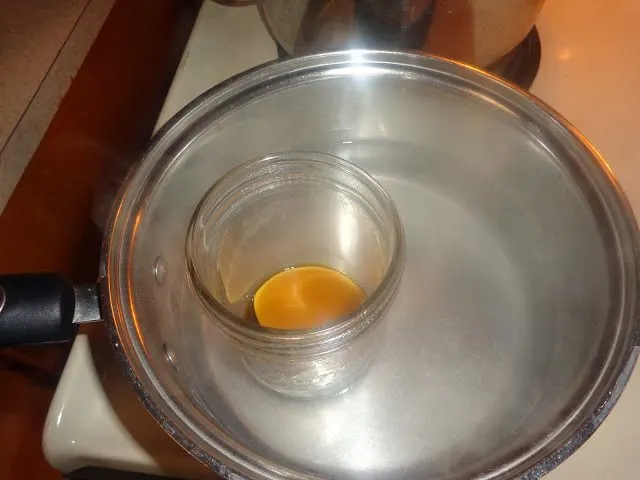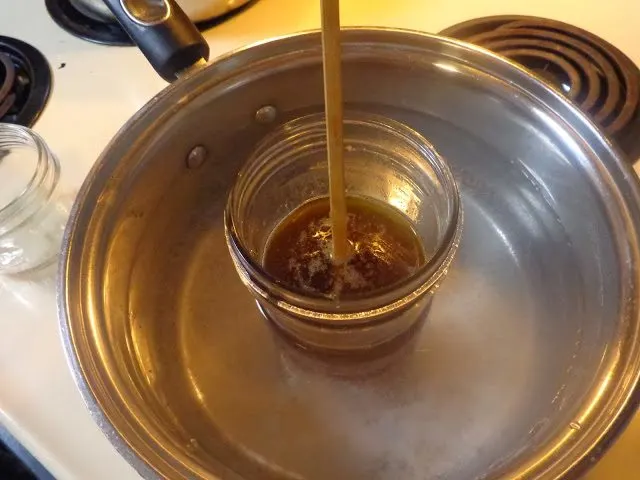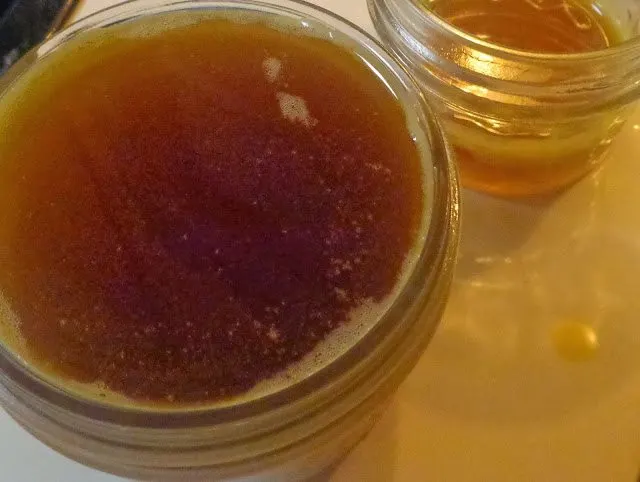
A few weeks ago, I was in the house, minding my own business, when I felt our house shake. Now, we have a brick house, so a shaking house is no small feat. A moment later, Benjamin’s friend came in the house saying that Benjamin was hurt.
Apparently, the two of them were racing bikes and Benjamin was winning. He turned around just for a moment – to gloat, I’m sure – and when he turned back around, the house was right there. His bike hit the house and then his entire chest hit the house. I’m guessing he slid down the brick because his chest was full of “road rash” or in this case, “brick house rash”.
So, I did what any mom would do, I smeared it with raw honey, wrapped him in cheese cloth and told him to stay away from the bee yard.
I wasn’t sure how long an 11 year old boy would walk around smelling like honey so I went to work making a basic healing salve that we could rub on the rash but wouldn’t be so sticky that it needed to be covered with cheese cloth.

I started by melting about 1 oz (weight) of beeswax in a pan of water. I’m using a pint size wide mouth canning jar to make the salve. When the beeswax was melted I turned off the heat. You don’t want to heat beeswax too much or it will destroy the enzymes.

Then I added in 1/2 cup of coconut oil and stirred with my handy dandy chopstick.

I chose these essential oils and herbal extracts because I had them in my cabinet and because they both have great antibacterial and antimicrobial properties. Tea Tree oil is also used as an antiseptic, antiviral, expectorant, fungicide, insecticide, stimulant and sudorific substance. And plantain has anti-inflammatory and antitoxic properties. It also relieves and soothes insect bites and stings and poison ivy.
By switching out the essential oils and infused oils, you can make a salve for almost anything. You can also make a body butter or even a decongestant salve, like Vicks only better.
Over the years I’ve used a lot of different brands of essential oils. I’m now in the process of just using Rocky Mountain Oils. They have quality oils and make each batches GC/MS test results available, they also practice environmental sustainability in harvesting, packaging, and recycling. These are things that are important to me.
A note about texture. My salve is pretty firm, I did that on purpose For this, I didn’t want a salve that would need a lot of rubbing in, also several of my teens are using this on their faces as a moisturizer to help with some acne issues they are having.
If you want your salve to be more lotion like, just use less beeswax. Or use more oil. You can even use some olive oil instead of all coconut oil.

Have you ever made a salve? What are your favorite herbal combinations?

Monica
Sunday 3rd of July 2022
Hello,
I want to try making this for after a cold sore. Where can I get beeswax? Can I add essential oils to this?
Angi Schneider
Sunday 24th of July 2022
I'd ask around at your local farmer's market to get beeswax. If none has a recommendation then you can order online from Starwest Botanicals. I do have a cold sore remedy recipe that works great and doesn't use beeswax, it's put in a roller ball bottle.
Latha Steinbronn
Sunday 15th of April 2018
Thank you!
Latha
Sunday 15th of April 2018
I have not heard of plantain oil. What is it?
Angi Schneider
Sunday 15th of April 2018
Hi Latha, I used plantain extract (tincture) not plantain oil. Plantain is an her that is well known for using on skin issues. You can make an infused oil with dried plantain leaves but for this salve I just used plantain tincture because that's what I had.
Anjanette
Wednesday 26th of February 2014
Ouch! :) But thanks for sharing! We use solid coconut oil mixed with essential oils for everything! I'm lazy and haven't purchased any beeswax but I know I need to to make our salves easier to apply. Coconut oil melts and runs everywhere on contact, of course! I do have a couple of lotion bars that are heavy on the beeswax that we use for dry/chapped skin that I really like!
Thanks for linking up to Wellness Wednesday a few weeks ago - I'm featuring you today! :)
Angi Schneider
Friday 28th of February 2014
Awww, thanks so much, Anjanette! The beeswax really helps with firming up the salves but honestly, if my son wasn't a beekeeper I'm not sure I'd have any either.
Mary Woollard
Thursday 23rd of January 2014
Thank you for sharing at the Homeacre Hop! I've had this on my to-do list for some time. I've really got to try this soon. Please join us again at: www.homegrownonthehill.blogspot.com. Mary :)